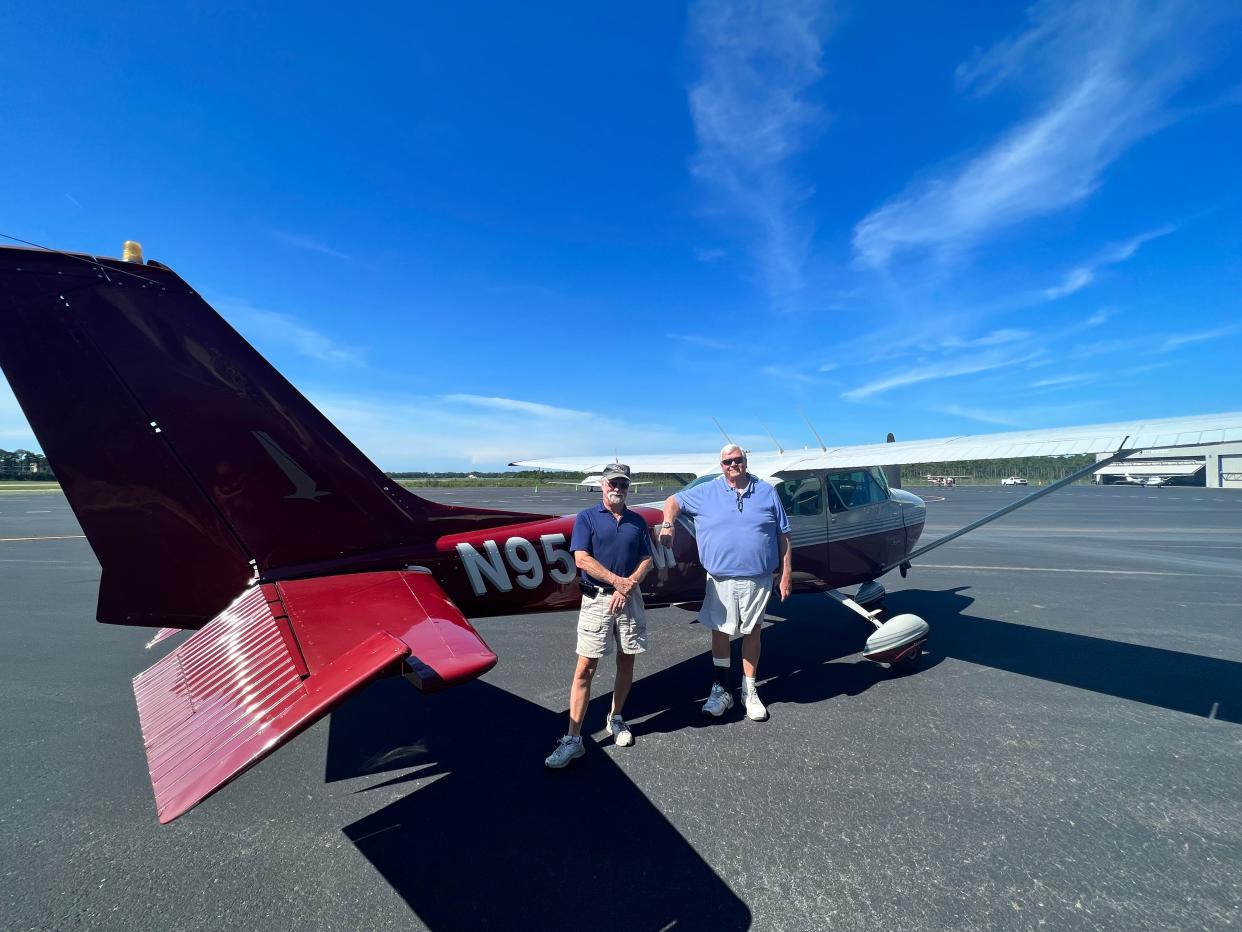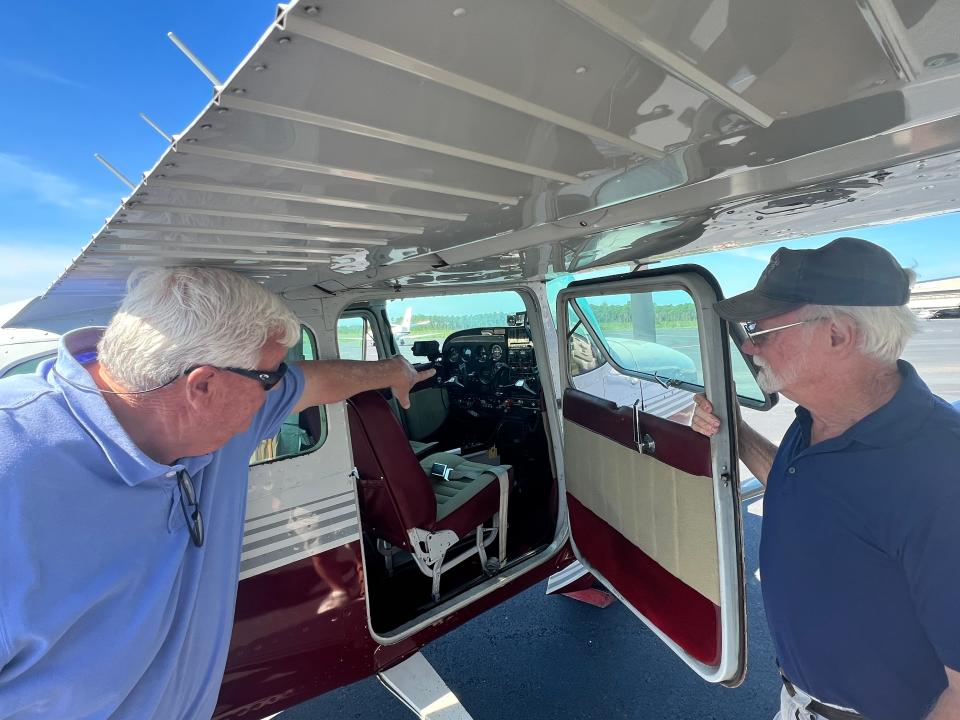Amid recent plane crashes in the area, Wilmington pilots recall scary experiences

Greg Vaughn grew up around airplanes. His father was a military pilot and made a career in aviation.
Now Vaughn himself has been a pilot for several decades. In that time, he’s logged more 20,000 hours and flown more than 200 different aircraft in various scenarios.
But no matter how much time he spends in the air, the Oak Island resident never forgets that the air is not his natural habitat.
“It’s not our element,” he said.
For many, that’s part of the allure. Vaughn compared flying to scuba diving.
“You know, why do people like to do scuba diving? It’s not our element,” he explained. “As soon as you think it is your element, you’re probably going to get bit. That’s what they tell scuba divers. The fish live there, the sharks live there, sea creatures live there, you’re just visiting. You’re not equipped to do what they do.”
Recently, people across the Cape Fear region have been reminded that humans are not naturally acclimated to fly. Over the last month, there have been four aviation incidents around the region: a crash in a residential area of Southport that killed the pilot on June 25; a crash in North Myrtle Beach, South Carolina that killed five people on July 2, an incident that involved a sea plane near Bald Head Island on July 7, and an incident about a week where a plane made a hard landing at Cape Fear Regional Jetport.
After witnessing several incidents in such a short period, many are wondering about the safety of the general aviation industry and why people continue to fly when there’s so much potential for peril.
Experienced pilots like Vaughn acknowledge the risk in aviation. However, they also say there’s a tremendous amount of responsibility, and when that is coupled with training and adherence to the regulations, flying is much safer than people think — and worth the risk.
A major commitment
Those who have obtained a private pilot’s certification will tell you it’s not something done on a whim.
When one first looks at the requirements on the Federal Aviation Administration’s website, the process doesn’t sound too difficult. One must be at least 17 years old, and pass both a written knowledge and practical flight test to acquire a recreational or private pilot’s certification. But passing those tests requires many hours of instruction, and that can be costly.
“To get a private pilot’s license today, I would say going to a flight school, you could figure on $12,000-$14,000 and probably a hundred days of attendance,” Vaughn said.
Rich Largent, private pilot and president of Experimental Aviation Association Chapter 939, earned his pilot’s certification later in life. He explained learning to fly is based on repetition and building on previous concepts.

“It does not come naturally to most people,” he said. “So, it’s a learned behavior, reinforced by repetition, and depending on how well you do with the repetition is a good indicator of how much it’s going to cost.”
It takes the average person about 9 to 14 months to obtain their private pilot’s certification, and Vaughn noted that’s just the beginning. Additional training is required for instrument, commercial, instructor, and Airport Transport Pilot ratings.
Both Vaughn and Largent said after earning the certification, it’s important for pilots practice flying regularly.
“I will tell you that the mechanics and concepts are easily understood,” Vaughn said. “But the regulations and what I call the ‘what-ifs’ are very difficult to teach and understand.”
Pilots must know and adhere to the Federal Aviation Administration’s regulations and the Airmen’s Information Manual, and they also must be familiar with facilities and navigation charts.
“Those things are what make learning to fly more complicated and require dedication to study and experience,” Vaughn said. “And there’s no substitute for study and experience.”
“Once you have attained your license, it’s not something you can do casually,” Largent agreed. “If you do it casually, you’re probably going to put yourself in a bad way.”
Though they’ve been flying a while, Vaughn and Largent still try to fly at least once a week. In addition to flying regularly, both men say there’s a tremendous amount of personal responsibility in keeping current with FAA requirements, which include regular medical examinations, annual aircraft inspection, and a biennial flight review, which includes flight and ground instruction.
'No substitute' for training and experience
According to the Federal Aviation Administration, there are 6,726 aircraft registered in North Carolina, and the majority of those are used for general aviation, which means they are not for commercial or airline use. Of those only 324 are in the Cape Fear region: 103 in Brunswick, 177 in New Hanover, and 44 in Pender County.
As a popular tourist destination, the area sees most of its general aviation air traffic from visitors. A recent report from Aviation Impact Reform, an organization that advocates for transparency and reform of the Federal Aviation Administration, shows Cape Fear Regional Jetport is the fourth busiest airport in the state behind only Charlotte-Douglas International, Raleigh-Durham International, and Piedmont Triad International. Cape Fear Regional Jetport averages 211 operations daily, and of those, only about 39 percent are local aircraft.
Data from the National Transportation Safety Board (NTSB) shows take-offs and landings are when most accidents occur. From 2012 to 2021, there were 12,368 accidents reported to the NTSB, and of those 4,008 occurred on landing and 1,469 occurred on take-off.
But both Vaughn and Largent note not everything constitutes a “crash.” Vaughn noted in the case of the sea plane that flipped near Bald Head Island, the pilot was experienced and was attempting to take off when the plane was struck by a rouge wave, flipping it over. The two people on board the aircraft were picked up by a passing board and were uninjured.
“They were both fine,” Vaughn said. “I had coffee with them the next morning.”
That’s where training and experience come into play.
Both Vaughn and Largent say they’ve had close calls. Vaughn’s had two of them. In one of the instances, he just had the annual inspection conducted on his plane and took off as soon as it was completed.
“And I failed to adequately fulfill my responsibility and check the oil,” Vaughn explained. “The plane right out of an annual inspection, and I just assumed, and we all know what happens when you assume.”
The two mechanics working on the plane had each thought the other one had filled the right engine with oil. Vaughn said the plane showed enough oil pressure during his pre-flight “run-up,” and took off. Soon after, the right engine “froze up,” and he had to land his twin-engine aircraft with only the left engine.
“Fortunately, I was alone, didn’t have any passengers, and the plane was fairly light,” he said. “So, I got lucky there.”
His second incident involved a small airplane with retractable landing gear that would not go down mechanically or manually, forcing him to land the plane without the gear.
“Again, no big deal,” he said.
Vaughn credits his experience and training for making the difference in both circumstances.
Largent said his incident occurred at night and required experience for night flying. His plane engine developed carburetor ice, and the engine began to run “really poorly.” Largent hadn’t really considered the possibility of the engine icing because it very rarely happens on take-off. When he began having problems, he was able to keep the plane running and get it back on the ground. Once he landed, he consulted a mechanic who told him about carburetor ice, and Largent said storing it in a hangar would prevent the icing.
“You don’t want to learn those lessons that way, but sometimes, that’s what happens,” he said.
Both men say after something like that happens, it becomes a personal challenge to learn from it and make sure it never happens again.
“It’s either do that or quit,” Vaughn said.
And both men say once flying fever has taken hold, quitting is not an option.
“It’s great to be in that other element,” Vaughn said. “As pilots, there’s things we see and feel, and certainly things we can do as travelers, that John Doe cannot, but I think that’s the interest.”
Largent said he enjoys the freedom flying offers.
“We get to do this; we have the freedom to do this in this country, but there is a huge responsibility that comes with it to do it,” Largent said.
As president of the Experimental Association Chapter, which offers free flights to children through its Young Eagles program. Largent notes many times, the children’s parents are apprehensive about letting them fly without them. Largent’s wife helps with registration for the Young Eagles flights, and nervous parents would often ask about his experience and skills as a pilot.
“Inevitably, someone would always ask her, ‘Is he a good pilot,’ and for many years, she wasn’t sure how to answer that question. It was kind of awkward,” he recalled.
But one day, his wife came up with the perfect response, and he said it’s the most important thing to remember when thinking about the risks of flying and a pilot’s responsibility.
“She just looked at them and said, ‘Remember, he wants to come back, too,” Largent recalled.
STAY CONNECTED: Keep up with the area’s latest Brunswick County news by signing up for the Brunswick Today newsletter and following us on Facebook and Instagram.
This article originally appeared on Wilmington StarNews: Wilmington pilots on risks while flying

